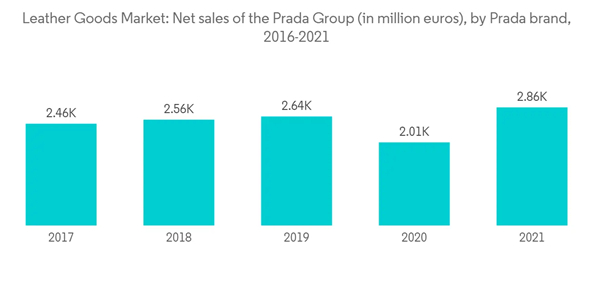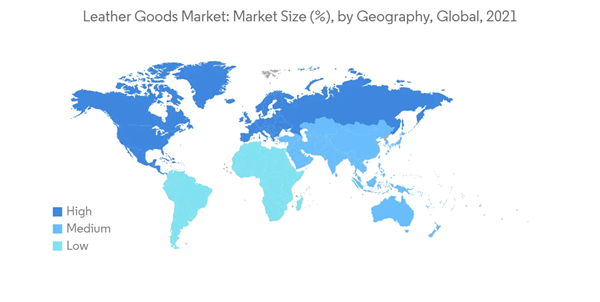The Leather Goods Market size is estimated at USD 304.80 billion in 2024, and is expected to reach USD 376.21 billion by 2029, growing at a CAGR of 4.30% during the forecast period (2024-2029).
In the clothing industry, there is an increased use of leather due to its durable nature and premium appearance, which make it an excellent choice for clothing production. This is one of the major factors driving the uptake of leather in the market at the moment. Furthermore, leather goods are becoming increasingly popular as a result of fashion shows that showcase leather goods like jackets, shoes, bags, and other accessories that are promoting leather goods in the forecast period. The market players are introducing innovative and trendy products to meet the demands of the consumers and to maintain a loyal customer base, which is contributing to the growth of the market.
Additionally, consumers prefer compact and stylish leather goods and luggage. With changing fashion trends, men's accessories like leather bracelets, necklaces, and gloves are becoming increasingly popular. Thus, in the coming years, fashion trends are likely to change significantly, which will help to grow the industry. Furthermore, the growing government support for the leather industry is further driving market growth. For instance, in India, 100% FDI is allowed for the manufacturing of leather products through an automatic route. Between April 2000 and September 2021, the cumulative foreign direct investment (FDI) inflow in the case of the leather, leather goods, and pickers industries was USD 218.69 million.
Hence, the companies are expanding their product portfolios with new product launches to attract extravagant customers. For instance, in August 2022, luxury brand Aman Essentials launched the first collection of leather products in its extensive range. In addition to passport cases, handbags, wallets, and more, the brand's new Leather Collection includes 19 items. Using authentic leathers sourced from artisanal calf, lamb, and goat skins, each of the leather items in the new collection is handcrafted in Italy and France using a process that is inspired by traditional artisanal processes.
Furthermore, various brands are expanding their product portfolios in the men's segment as fashion consciousness grows among men and women. There is also a growing segment of the market for affordable luxury brands in addition to traditional luxury brands. As a result, a number of startups have created customized luxurious products that cater to the needs of consumers. A leather handbag from 1 Atelier, for example, can be customized in both color and hardware. Sales of these products are driven by their strong brand recognition and high unit price.
In the international leather trade, Europe plays an important role. According to the UN Comrade database, in 2021, the number of leather goods imported into France increased significantly, reaching approximately USD 5.22 billion, up from USD 4.2 billion in the previous year. Additionally, leather is the world's largest international export from the EU industry. Among the leather goods exported by Europe in 2021, approximately USD 31.9 billion, compared to USD 24.8 billion the previous year, was reported by the International Trade Centre. In terms of raw materials and leather, the European Union produces some of the highest-valued calfskins. A majority of tanners in the European Union are family-owned, small- and medium-sized enterprises with strong regional concentrations. The availability of raw materials and export markets is crucial for tanners in the European Union.
This product will be delivered within 2 business days.
In the clothing industry, there is an increased use of leather due to its durable nature and premium appearance, which make it an excellent choice for clothing production. This is one of the major factors driving the uptake of leather in the market at the moment. Furthermore, leather goods are becoming increasingly popular as a result of fashion shows that showcase leather goods like jackets, shoes, bags, and other accessories that are promoting leather goods in the forecast period. The market players are introducing innovative and trendy products to meet the demands of the consumers and to maintain a loyal customer base, which is contributing to the growth of the market.
Additionally, consumers prefer compact and stylish leather goods and luggage. With changing fashion trends, men's accessories like leather bracelets, necklaces, and gloves are becoming increasingly popular. Thus, in the coming years, fashion trends are likely to change significantly, which will help to grow the industry. Furthermore, the growing government support for the leather industry is further driving market growth. For instance, in India, 100% FDI is allowed for the manufacturing of leather products through an automatic route. Between April 2000 and September 2021, the cumulative foreign direct investment (FDI) inflow in the case of the leather, leather goods, and pickers industries was USD 218.69 million.
Leather Goods Market Trends
Increased Demand for Luxury Goods
As people's spending money has gone up, the demand for luxury goods has also gone up.These goods often symbolize a sense of accomplishment within individuals, giving them higher self-esteem. Europeans and North Americans are known to spend most on luxury goods, owing to their higher household incomes. An upward thrust can be seen in this matter in the Asian region as well. Leather goods form a major part of luxury goods. Luxury leather products include exclusive handbags, accessories, and shoes, which appeal to affluent individuals.Hence, the companies are expanding their product portfolios with new product launches to attract extravagant customers. For instance, in August 2022, luxury brand Aman Essentials launched the first collection of leather products in its extensive range. In addition to passport cases, handbags, wallets, and more, the brand's new Leather Collection includes 19 items. Using authentic leathers sourced from artisanal calf, lamb, and goat skins, each of the leather items in the new collection is handcrafted in Italy and France using a process that is inspired by traditional artisanal processes.
Furthermore, various brands are expanding their product portfolios in the men's segment as fashion consciousness grows among men and women. There is also a growing segment of the market for affordable luxury brands in addition to traditional luxury brands. As a result, a number of startups have created customized luxurious products that cater to the needs of consumers. A leather handbag from 1 Atelier, for example, can be customized in both color and hardware. Sales of these products are driven by their strong brand recognition and high unit price.
Europe Emerges as the Largest Consumer of Leather Goods
Some of the main things that are making the European market grow are the large number of local and international players, new products and technologies, the rise of online shopping, and the use of social media platforms.The increasing fashion consciousness, rising disposable incomes, and increasing demand for attractive bags drive the sales of luggage and leather goods in the region. Moreover, the growing interest in travel and unique experiences among consumers is boosting the demand for leather goods, such as luggage bags, especially in the luxury segment, as consumers increasingly look for high-quality items. Furthermore, with the strong presence of fashion-driven countries such as France and Italy, the region remains the market's largest consumer.In the international leather trade, Europe plays an important role. According to the UN Comrade database, in 2021, the number of leather goods imported into France increased significantly, reaching approximately USD 5.22 billion, up from USD 4.2 billion in the previous year. Additionally, leather is the world's largest international export from the EU industry. Among the leather goods exported by Europe in 2021, approximately USD 31.9 billion, compared to USD 24.8 billion the previous year, was reported by the International Trade Centre. In terms of raw materials and leather, the European Union produces some of the highest-valued calfskins. A majority of tanners in the European Union are family-owned, small- and medium-sized enterprises with strong regional concentrations. The availability of raw materials and export markets is crucial for tanners in the European Union.
Leather Goods Industry Overview
The leather goods market is highly competitive. In the organized sector, a few key players hold a major market share, whereas in the unorganized sector, many small players are competing to gain market share. Adidas, Samsonite, and Kering are some prominent players in the global market. Major players are focusing on introducing new product offerings in the market to cater to the interests of consumers as per the ongoing fashion trend among goods like footwear, accessories, and luggage bags. Expansion is the next strategy preferred by companies to strengthen their dominance in the leather goods market. Major players are constantly trying to expand their production facilities or retail outlets to accommodate the growing demand and strengthen their strategies for market development.Additional Benefits:
- The market estimate (ME) sheet in Excel format
- 3 months of analyst support
This product will be delivered within 2 business days.
Table of Contents
1 INTRODUCTION
4 MARKET DYNAMICS
5 MARKET SEGMENTATION
6 COMPETITIVE LANDSCAPE
Companies Mentioned (Partial List)
A selection of companies mentioned in this report includes, but is not limited to:
- Kering SA
- Hermes
- Samsonite IP Holdings S.AR.L.
- Tapestry Inc.
- Adidas AG
- Prada
- LVMH
- Capri Holdings Limited
- Moncler SpA
- Compagnie Financiere Richemont SA
Methodology

LOADING...










